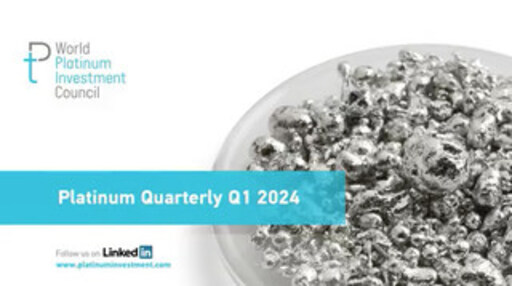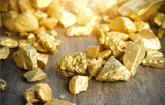WPIC: Impact of COVID-19 on Platinum Market Less Than Expected
- 2020 demand down 18% but supply down 13%
- Forecast 2020 surplus of 247 koz only 128 koz higher than previously forecast
- Investors act on price fall as demand for bars and coins surges to 19% of total demand in Q1 2020 from 2% in previous quarter
- Smelting process failure and more stringent auto emissions legislation major factors that limit surplus
LONDON, May 18, 2020 /PRNewswire/ -- The World Platinum Investment Council (WPIC) today published its Platinum Quarterly for the first quarter of 2020, which also includes a revised 2020 forecast.
While the COVID-19 pandemic has had a major negative effect on the platinum market — including price, demand and supply — the results for Q1 2020 show the net effect is less than feared, and the outlook for 2020 is better than expected.
The platinum price fell together with that of most equities and metals during March; suffering falls of between 10% and 35%. Platinum demand in China reduced early in the quarter. However, a smelting process failure in South Africa, unrelated to the pandemic, as well as mine closures to reduce the spread of the virus significantly reduced quarterly platinum supply.
Total demand in Q1 2020 declined by 5% (-94 koz) to 1,649 koz from the previous quarter. Meanwhile, total supply decreased by 19% (-410 koz) to 1,773 koz from Q4 2019. This resulted in a surplus of 124 koz for Q1 2020.
WPIC now forecasts that 2020 will have a surplus of 247 koz, which is only 128 koz higher than its previous forecast despite the impacts of COVID-19. Demand in 2020 is expected to be 18% lower than in 2019 mainly on weak automotive and jewellery sales and lower investment demand. Supply is forecast to be down 13%, year-on-year, on the material impact of the smelting outage and pandemic related mine stoppages.
Strong investment demand for bars and coins
First-quarter bar and coin investment surged to 312 koz in Q1 2020 – up over 300% on the quarterly average of 70 koz in 2019. This was driven by a jump in bar and coin demand in both Japan and the US, while demand in Europe also increased albeit from a low base. The increase was largely driven by bargain-hunting following the price fall in March. Bar and coin investment demand is expected to surge by 115% to 605 koz in 2020.
This comes at a time when the platinum price remains at historic discounts to itself, to gold and to palladium.
Implementation of more stringent automotive emissions legislation is likely to drive demand in 2020
Automotive demand in Q1'20 was down 17% (-132 koz) to 634 koz, year-on-year, as COVID-19 induced plant closures led to a rapid drop in manufacturing output and an unprecedented fall in sales. These stoppages, first in China but soon thereafter globally, reduced demand for platinum during the quarter.
While total automotive platinum demand is forecast to fall by 14% (-413 koz) in 2020, automotive demand in China is expected to increase by 14%, despite the effects of COVID-19. The phasing in of China VI standards for heavy-duty vehicles drives an increase in loadings that outweighs the expected decline in units produced. Similarly, the implementation in India of the Bharat VI legislation in April 2020, is also likely to increase demand for platinum, despite the lockdown restrictions that are currently in place.
Paul Wilson, CEO of World Platinum Investment Council commented: "Without warning, and almost overnight, COVID-19 has presented an unparalleled situation for the platinum market, with serious and negative direct effects on demand and supply. However, while these will be the focus of attention for many months to come, we must not forget the other shifting plates that also have the potential to increase demand for, and the value of, platinum. In fact, this demand growth potential is likely to remain long after the COVID-19 pandemic has been resolved. Reducing CO2 emissions remains a global imperative and automotive manufacturers in Europe have been preparing for this for several years. In 2020, we are likely to see increased platinum demand as automaker CO2 strategies include the wide range of diesel and diesel hybrid vehicles already on sale and which have higher platinum loadings. Palladium demand growth, unrelated to COVID-19, and its high price maintains the need for platinum to replace palladium in autocatalysts in the world's two largest passenger car markets, China and North America.
"Our close relationships with product partners around the world have proved particularly valuable as the pandemic unfolded, keeping us close to market developments and providing us with additional insights. Through them, we are acutely aware of the response in China to the low platinum price, with sales of platinum on the Shanghai Gold Exchange (SGE) up from an average of 171 koz per quarter in 2019 to 455 koz in Q1'2020. We believe this to be a prudent value response by long-standing manufacturing participants in platinum, industrial and jewellery, increasing stock levels for short- or long-term benefit. Similarly, WPIC product partners in the US and Japan reported a surge in consumer buying of platinum bars and coins. Our working with these partners has increased awareness of platinum and it is exciting to see such exceptionally strong bar and coin performance. We are pleased to see reflected in the numbers we publish today, the boom that they are witnessing first-hand in the field."
Disclaimer
Neither the World Platinum Investment Council nor Metals Focus is authorised by any regulatory authority to give investment advice. Nothing within this document is intended or should be construed as investment advice or offering to sell or advising to buy any securities or financial instruments and appropriate professional advice should always be sought before making any investment. For further information, please visit www.platinuminvestment.com.
SOURCE World Platinum Investment Council (WPIC)

Related Links
https://platinuminvestment.com
WANT YOUR COMPANY'S NEWS FEATURED ON PRNEWSWIRE.COM?
Newsrooms &
Influencers
Digital Media
Outlets
Journalists
Opted In





Share this article